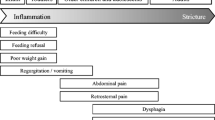Abstract
Smaller studies have suggested seasonal variation of the diagnosis of eosinophilic esophagitis with more patients being diagnosed in the aeroallergen season. We evaluated a large group of adult patients for a seasonal variation of the diagnosis of symptomatic eosinophilic esophageal infiltration. We performed a retrospective review of adult patients from a large Eosinophilic esophagitis database at the Mayo Clinic Rochester. We only included patients from three states in the upper Midwest, who had 15 or more eosinophils per high-power field on esophageal biopsy, symptomatic dysphagia, and were seen, in our Gastroenterology Clinic between 2000 and 2008. Clinical data were abstracted and the month of diagnosis was determined. The Rayleigh circular test and the Chi-square goodness-of-fit test were used to detect seasonality of symptomatic esophageal eosinophilia diagnosis and seasonality corrected for esophagogastroduodenoscopy monthly volume. The diagnosis of symptomatic eosinophilic esophageal infiltration was made in 372 patients. The mean number of eosinophils was 39.6 per high-power field. The December/January and May/June periods seem to have an increased presentation rate (p = 0.014). Of those tested, reactions to any aeroallergen was present in 69 % (48/70), reactions to >4 aeroallergens in 47 % (33/70) and reactions to any food allergen in 63 % (50/80) of patients. There was no evidence of monthly concentration of symptomatic esophageal eosinophilia diagnosis in the subgroups of patients with any positive aeroallergen, >4 positive aeroallergens, or history of atopy. The diagnosis of symptomatic esophageal eosinophilia is not made more frequently in the summer months.

Similar content being viewed by others
Abbreviations
- EoE:
-
Eosinophilic esophagitis
- HPF:
-
High-power field
- EGD:
-
Esophagogastroduodenoscopy
- PPI:
-
Proton pump inhibitor
References
Dellon ES, et al. ACG clinical guideline: evidenced based approach to the diagnosis and management of esophageal eosinophilia and eosinophilic esophagitis (EoE). Am J Gastroenterol. 2013;108:679–92. doi:10.1038/ajg.2013.71 quiz 693.
Spechler SJ, Genta RM, Souza RF. Thoughts on the complex relationship between gastroesophageal reflux disease and eosinophilic esophagitis. Am J Gastroenterol. 2007;102:1301–6.
Dohil R, Newbury RO, Aceves S. Transient PPI responsive esophageal eosinophilia may be a clinical sub-phenotype of pediatric eosinophilic esophagitis. Dig Dis Sci. 2012;57:1413–9. doi:10.1007/s10620-011-1991-5.
Peterson KA, et al. Elemental diet induces histologic response in adult eosinophilic esophagitis. Am J Gastroenterol. 2013;108:759–66. doi:10.1038/ajg.2012.468.
Liacouras CA, et al. Eosinophilic esophagitis: a 10 year experience in 381 children. Clin Gastroenterol Hepatol. 2005;3:1198–206.
Kagalwalla AF, et al. Effect of six-food elimination diet on clinical and histologic outcomes in eosinophilic esophagitis. Clin Gastroenterol Hepatol. 2006;4:1097–102.
Akei HS, Mishra A, Blanchard C, Rothenberg ME. Epicutaneous antigen exposure primes for experimental eosinophilic esophagitis in mice. Gastroenterology. 2005;129:985–94.
Straumann A, et al. Natural history of primary eosinophilic esophagitis: a follow-up of 30 adult patients for up to 11.5 years. Gastroenterology. 2003;125:1660–9.
Fogg MI, Ruchelli E, Spergel JM. Pollen and eosinophilic esophagitis. J Allergy Clin Immunol. 2003;112:796–7.
Onbasi K, et al. Eosinophil infiltration of the oesophageal mucosa in patients with pollen allergy during the season. Clin Exp Allergy. 2005;35:1423–31.
Prasad GA, et al. Epidemiology of eosinophilic esophagitis over three decades in Olmsted County, Minnesota. Clin Gastroenterol Hepatol. 2009;7:1055–61. doi:10.1016/j.cgh.2009.06.023.
Wang FY, Gupta SK, Fitzgerald JF. Is there a seasonal variation in the incidence or intensity of allergic eosinophilic esophagitis in newly diagnosed children? J Clin Gastroenterol. 2007;41:451–3.
Almansa C, et al. Seasonal distribution in newly diagnosed cases of eosinophilic esophagitis in adults. Am J Gastroenterol. 2009;104:828–33.
Moawad FJ, et al. Correlation between eosinophilic oesophagitis and aeroallergens. Aliment Pharmacol Ther. 2010;31:509–15.
Sorser SA, Barawi M, Hagglund K, Almojaned M, Lyons H. Eosinophilic esophagitis in children and adolescents: epidemiology, clinical presentation and seasonal variation. J Gastroenterol. 2013;48:81–5. doi:10.1007/s00535-012-0608-x.
Elitsur Y, Aswani R, Lund V, Dementieva Y. Seasonal distribution and eosinophilic esophagitis: the experience in children living in rural communities. J Clin Gastroenterol. 2013;47:287–8. doi:10.1097/MCG.0b013e31826df861.
van Rhijn BD, Verheij J, Smout AJ, Bredenoord AJ. Rapidly increasing incidence of eosinophilic esophagitis in a large cohort. Neurogastroenterol motil. 2012;25:47–5200000. doi:10.1111/nmo.12009.
Batschelet E. Circular statistics in biology/Edward Batschelet. London: Academic Press Inc; 1981.
Peterson KA, et al. Comparison of esomeprazole to aerosolized, swallowed fluticasone for eosinophilic esophagitis. Dig Dis Sci. 2009;54:1818.
Remedios M, Campbell C, Jones DM, Kerlin P. Eosinophilic esophagitis in adults: clinical, endoscopic, histologic findings, and response to treatment with fluticasone propionate. Gastrointest Endosc. 2006;63:3–12.
Francis DL, et al. Results of ambulatory pH monitoring do not reliably predict response to therapy in patients with eosinophilic oesophagitis. Aliment Pharmacol Ther. 2012;35:300–7. doi:10.1111/j.1365-2036.2011.04922.x.
Furuta GT, et al. Eosinophilic esophagitis in children and adults: a systematic review and consensus recommendations for diagnosis and treatment. Gastroenterology. 2007;133:1342–63.
Alexander JA, et al. Swallowed fluticasone improves histologic but not symptomatic response of adults with eosinophilic esophagitis. Clin Gastroenterol Hepatol. 2012;10(742-749):e741. doi:10.1016/j.cgh.2012.03.018.
Prasad GA, et al. Epidemiology of eosinophilic esophagitis over three decades in Olmsted County, Minnesota. Clin Gastroenterol Hepatol. 2009;7:1055–61. doi:10.1016/j.cgh.2009.06.023.
Dohil R, Newbury R, Fox L, Bastian J, Aceves S. Oral viscous budesonide is effective in children with eosinophilic esophagitis in a randomized, placebo-controlled trial. Gastroenterology. 2010;139:418–29.
Straumann A, et al. Budesonide is effective in adolescent and adult patients with active eosinophilic esophagitis. Gastroenterology. 2010;139:1526–37.
Lee J, et al. Esophageal diameter is decreased in some patients with eosinophilic esophagitis and might increase with topical corticosteroid therapy. Clinical gastroenterology and hepatology : the official clinical practice journal of the American Gastroenterological Association. 2012;10:481–6. doi:10.1016/j.cgh.2011.12.042.
Conflict of interest
None of the authors declare any conflict of interest.
Author information
Authors and Affiliations
Corresponding author
Additional information
Research was conducted at the Mayo Clinic in Rochester, MN.
Rights and permissions
About this article
Cite this article
Elias, M.K., Kopacova, J., Arora, A.S. et al. The Diagnosis of Esophageal Eosinophilia is Not Increased in the Summer Months. Dysphagia 30, 67–73 (2015). https://doi.org/10.1007/s00455-014-9574-1
Received:
Accepted:
Published:
Issue Date:
DOI: https://doi.org/10.1007/s00455-014-9574-1




